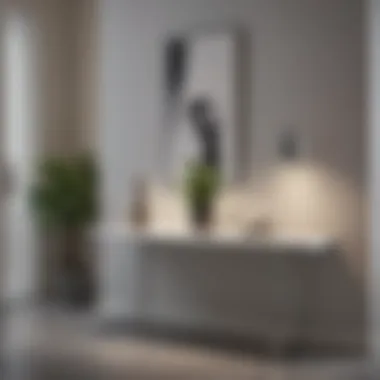Exploring Slim Entry Way Tables: Utility Meets Style


Intro
Slim entryway tables have found their way into many homes, largely due to their functional versatility and stylish appeal. These tables are designed to occupy minimal floor space while offering ample utility, making them ideal for narrow hallways or limited entry spaces. As homes become increasingly designed for efficiency, the incorporation of slim tables highlights a growing trend in interior design—merging practicality with aesthetic value.
The significance of slim entryway tables extends beyond mere functionality. Their design can instantly elevate the entrance of a home, providing a taste of the overall interior style. They often act as a focal point, introducing colors, textures, and styles that set the tone for the rest of the space. Homeowners and design enthusiasts are, therefore, wise to understand how to incorporate these tables effectively into their interior layouts.
Key Insights and Trends
Current Trends in Interior Design
In recent years, interior design has gravitated toward minimalism, emphasizing clean lines and uncluttered spaces. Slim entryway tables fit well into this trend, serving both as practical surfaces for keys and mail and as display areas for decorative elements such as plants or artwork. Materials such as light wood, glass, and metal are especially in vogue, harmonizing with neutral color palettes that promote tranquility and openness.
Further, the rise of multifunctional furniture is notable. Many slim entryway tables now include drawers or shelves, catering to the need for storage in smaller homes. Functional designs often feature innovative ways to hide clutter, emphasizing a streamlined look without sacrificing practicality.
Popular Styles and Materials
There is a rich variety of styles that appeal to different tastes. Some popular styles include:
- Scandinavian: Characterized by simplicity and natural materials, these tables often feature light woods and minimalist designs.
- Industrial: These tables typically use metal and reclaimed wood, conveying a rugged elegance that suits urban settings.
- Modern Farmhouse: Elements such as distressed wood and neutral colors create a warm, inviting entry point.
The materials selected for slim entryway tables also contribute to their overall aesthetic. Wooden tables can create a cozy feel, while metal and glass options can contribute a sleek look, ensuring there is a table that complements any existing decor.
Practical Tips and How-To Guides
When selecting a slim entryway table, consider the following:
- Size and Proportion: Measure the entryway space to ensure the table fits without overcrowding the area.
- Functionality: Think about how the table will be used—do you need extra storage? A table with shelves or drawers could be beneficial.
- Style Compatibility: Choose a table that matches or complements your existing decor to create a cohesive look.
Styling Your Slim Entryway Table
Arranging the decor on the table is as important as selecting the right piece. Here are some tips for styling:
- Use a statement piece like a bold vase or artwork to create interest.
- Incorporate functional items like trays for keys or small decor elements, but avoid clutter.
- Layer different heights to create visual appeal.
"Slim tables are not just furniture; they are art forms that enhance the space while serving practical purposes."
To maintain the table:
- Dust regularly to prevent buildup.
- Use coasters to protect the surface from stains.
- Clean spills immediately to avoid damage.
By applying these insights, homeowners can maximize the utility and style of slim entryway tables, thus enhancing their living spaces effectively.
Preface to Slim Entry Way Tables
Slim entry way tables, often overlooked, hold significant value in interior design. These tables serve a multifaceted purpose, blending utility with aesthetics. They occupy minimal space while providing a surface for decorative items or essentials. In smaller homes, this kind of furniture is invaluable, maximizing functionality without weighing down the layout. Moreover, their diverse designs appeal to various tastes, suit different styles, and enhance entryways effectively.
Definition and Purpose
Slim entry way tables can be described as narrow furniture pieces typically placed near doorways. Their primary purpose is to offer an area to place items like keys, mail, or decorative objects. The compact nature of these tables allows for their placement in tight spaces, making them ideal for apartments or small houses. They are often used as a transitional piece, guiding visitors from the external environment into the more personal areas of a home. The ability to support not just practical use, but also to serve as a decorative element means slim entry way tables often act as a focal point in a room.
Historical Context
The evolution of entry way tables reflects broader trends in home design and functionality. Historically, entrance furniture showed status and style. Further back, tables were large and ornate, aimed at showcasing wealth. As living spaces evolved towards minimalism and practicality, the demand for slimmer, more space-efficient designs grew. Nowadays, slim entry way tables are often designed with contemporary materials and aesthetics in mind, catering to the modern homeowner’s needs. The shift from large, bulky furniture to easily integrated slim tables shows a change in how we view space and functionality in our homes.
Functional Advantages


Slim entry way tables present a unique blend of utility and style. Their design allows for various practical applications without dominating space, making them essential for modern living. Their modest width does not detract from the flow of a room while serving as a functional placement for items. This section highlights both the space efficiency and the multi-purpose uses of these tables, showcasing how they can cater to various needs.
Space Efficiency
Space efficiency is a defining characteristic of slim entry way tables. These tables occupy minimal floor space while offering practical surfaces for essential items. Homes in urban settings often struggle with limited entryway areas. A slim table can fit snugly into tight corners or narrow hallways, serving to maximize functional space without encumbering movement.
Having a slim entry way table allows homeowners to keep entry areas organized. Keys, mail, and other daily necessities can easily find a home on these surfaces. By maintaining an organized and tidy environment, visitors receive a positive impression upon arrival. The added benefit is that they typically come in a variety of heights and widths, allowing customization based on specific space constraints.
Multi-Purpose Uses
Slim entry way tables are not merely practical; they also adapt to numerous purposes.
Plant Display
Using slim tables for plant displays enhances the overall aesthetic of an entryway. Plants add life and color to spaces, fostering a welcoming atmosphere. Slim tables provide an elevated surface for greenery, allowing one to showcase favorite plants without overwhelming the area. The key characteristic of plant displays is their capacity to breathe life into an otherwise sparse entry way.
Moreover, these tables can handle various plant types, from small succulents to medium-sized ferns. However, it is essential to consider the maintenance required. Over time, plants may need watering, which could create mess. Therefore, choosing low-maintenance plants can be more practical.
Storage Solutions
Slim entry way tables can excel as storage solutions. They often come with shelves or drawers integrated into their designs. This feature allows for seamless storage of items like gloves, scarves, or shoes. It's beneficial, as it keeps entryways decluttered and functional. The unique structure of these tables often means they can house useful compartments without appearing bulky.
However, homeowners should be cautious about the amount stacked onto the table. Excess items can lead to a cluttered appearance, countering the initial aim of organization.
Decorative Elements
Decorative uses of slim entry way tables are notable as well. They serve as platforms for artwork, mirrors, or lighting fixtures. This characteristic makes them versatile in enhancing the visual appeal of an entry space. With careful selection of decorations, homeowners can express their style and create focal points in their homes.
Moreover, these tables can easily be changed to suit seasons or events. A simple swap of decorative items can rejuvenate the entry way, making guests feel new energy in the space. However, it is important not to overcrowd the table, as this can diminish its effectiveness in enhancing aesthetics.
"Slim entry way tables provide a beautiful mix of functionality and style, proving essential for both small and spacious homes."
In summary, slim entry way tables are invaluable. They maximize space efficiency, support various purposes such as plant display, storage, and decoration, and adapt accordingly. Homeowners should weigh these functional benefits when selecting the right table for their needs.
Design Options
The design options available for slim entry way tables play a critical role in their overall functionality and aesthetic appeal. Choosing the right material and style can greatly enhance the visual harmony of an entryway while also improving practicality. This section will explore the various materials and styles available, shedding light on their unique contributions to the design and functionality of slim entry way tables.
Materials Used
Wood
Wood is a timeless choice for furniture, including slim entry way tables. Its natural warmth and versatility allow it to blend seamlessly with multiple decor styles. One key characteristic of wood is its durability; it can withstand daily use without losing its charm. Popular options include oak, walnut, and pine, each offering distinct grains and colors.
Wood's unique feature is its adaptability. It can be stained or painted to match existing decor, providing flexibility. However, disadvantages exist, such as susceptibility to scratches or moisture damage. Regular maintenance, like polishing, can help mitigate these issues.
Metal
Metal tables are often chosen for their modern aesthetics and strength. They can offer a sleek, industrial look that appeals to contemporary tastes. One significant characteristic of metal is its resilience; it resists dents and can handle heavy items with ease.
A unique feature of metal is its potential for intricate designs, such as cut-outs or geometric shapes. However, it can be prone to rust if exposed to moisture. Therefore, it’s advisable to choose finishes that protect against corrosion.
Glass
Glass tables introduce an element of sophistication and visual lightness to entryways. This material reflects light, making spaces appear larger and more open. A key characteristic of glass is its ability to complement almost any style due to its transparency.


The unique aspect of glass tables lies in their combination with other materials. For instance, a glass top on a wooden or metal frame can create an elegant juxtaposition. On the downside, glass can be fragile and requires careful handling. Regular cleaning is also necessary to keep it streak-free and shiny.
Composite Materials
Composite materials, like MDF or plywood, are gaining popularity in modern design. These materials offer the look of wood at a lower price point, making them accessible for a wider audience. One key trait of composite materials is their lightweight nature, which can ease mobility when rearranging spaces.
A unique feature of composites is their variety in finishes, which can mimic the appearance of natural wood or have a more colorful design. However, they can be less durable than solid wood and may not hold up under heavy use. They also might not be suitable for extreme humidity or temperature changes.
Styles and Aesthetic Choices
Modern
Modern slim entry way tables emphasize minimalism and clean lines. They typically use simple forms and a limited color palette, resonating with contemporary design principles. A significant characteristic of modern tables is their multifunctionality, often incorporating storage solutions without compromising style.
The unique feature of modern design is its focus on function. Sleek designs allow for a streamlined appearance, which is visually appealing in smaller spaces. However, such designs may come at the cost of warmth, potentially making a space feel stark or uninviting.
Traditional
Traditional styles evoke a sense of nostalgia and comfort. Rich woods and ornate designs characterize these tables, creating an inviting atmosphere. A defining characteristic of traditional tables is their craftsmanship, often showcasing intricate details and finishes.
A unique aspect of traditional tables is their ability to convey heritage and maintain a timeless appeal. However, they may clash with more modern decor, leading to a less cohesive look in an eclectic space.
Scandinavian
Scandinavian design is recognized for its simplicity and functionality. It combines minimalistic aesthetics with natural materials, creating a warm, inviting look. A key characteristic of Scandinavian tables is their focus on usability as well as style, often combining practicality with beauty.
The unique feature of Scandi design is the emphasis on light colors and natural light, making spaces feel more open and airy. However, the understated nature of this style may not appeal to those who prefer bolder designs.
Industrial
Industrial styles are marked by raw materials and unfinished looks. Steel and distressed wood are common elements in these tables. One critical characteristic is their rugged charm, which adds character to an entryway.
A unique feature of industrial tables is the ability to integrate elements like exposed screws and bolts, enhancing the aesthetic. However, this style may not suit more refined or delicate interiors, as it can appear heavy and imposing.
Selecting the Right Slim Entry Way Table
Choosing the right slim entry way table is crucial for achieving a harmonious and functional entrance in your home. A well-selected table can enhance the beauty of a space while providing practical uses. Key elements such as size, style, and budget must align with your needs. Understanding the importance of these factors will help you make informed decisions and maximize the table's benefit in your entryway.
Evaluating Available Space
Measuring Dimensions
Measuring dimensions is perhaps the most critical step when selecting a slim entry way table. Accurate measurements ensure that the table fits well without overwhelming the space. A key characteristic of measuring is that it provides a clear understanding of the available area. This process is beneficial, as it prevents purchasing items that may be too large or too small, ensuring proportion and balance in the overall layout. One unique feature of measuring dimensions is that it considers height, width, and depth. This allows for a comprehensive perspective of how various tables will occupy the space, facilitating better choices. However, improper measuring can lead to dissatisfaction and costly returns, necessitating careful attention during this phase.
Considering Traffic Flow
Considering traffic flow is another essential aspect in the selection process of an entry way table. This consideration focuses on how people will move through the doorway and interact with the table. A key characteristic of analyzing traffic flow is its ability to enhance comfort and accessibility in an entrance space. This helps avoid potential obstructions and ensures that the entry area serves its purpose efficiently. A unique feature of this analysis is that it can reveal the best placement for not just the table but also other decorative or functional items around it. Prioritizing traffic flow can prevent frustrations during gatherings, as it allows guests to move freely. Nevertheless, if not considered carefully, one may end up with a design that feels cramped or chaotic in that entrance area.
Identifying Personal Style
Personal style should guide the selection process when choosing a slim entry way table. Understanding your aesthetic preferences can lead to a more fulfilling purchase. Think about how you want your entry space to reflect your taste. Are you leaning toward a modern, clean look or a more traditional style? This decision will influence not just the table but also the other elements in your entryway. Having a clear sense of style can enhance the overall atmosphere in your home and make guests feel welcomed.
Budgetary Considerations
Budgetary considerations are fundamental when selecting a slim entry way table. Setting a budget ensures that you do not overspend and can explore various options within your financial means. It is essential to balance quality and cost. Investing in a durable piece may save you money in the long run, as it is likely to need fewer replacements. Be open to exploring different styles; not everything high-priced is of excellent quality. Sometimes, budget-friendly options can fulfill both aesthetic and functional requirements just as well. Always keep in mind that a well-made product does not have to break the bank, and shopping wisely can lead to significant savings.


Styling Tips for Slim Entry Way Tables
The role of styling slim entryway tables is crucial in enhancing both the functionality and the aesthetic appeal of a home’s entrance. This area serves as the first impression for visitors and sets the tone for the rest of the space. Carefully styled tables create an inviting atmosphere while maximizing their utility for daily use. Here are a few important elements to consider when styling these tables.
Balancing Functionality and Aesthetics
When it comes to slim entryway tables, achieving a balance between functionality and aesthetics is key. These tables should not only look good but also serve a purpose. Functionality includes accommodating items like keys, mail, or small decorative pieces that enhance the welcome experience.
To ensure both aspects work together:
- Select appropriate accessories: Choose decor items that can be functional, like a stylish tray for keys or a small bowl for change. These pieces should complement the overall style of your home.
- Consider height and scale: A well-balanced display considers the proportions of items on the table. For instance, if using tall vases, pair them with lower, flatter items to create visual harmony.
- Create a focal point: Use a statement piece such as an eye-catching lamp or an art piece that draws attention without overwhelming the space. This can effectively balance functional items while being visually appealing.
Incorporating Personal Touches
Adding personal touches transforms a slim entryway table into a reflection of individual style. This is where homeowners can express their personality and tastes, making the table more than just a functional piece.
To add personal elements:
- Display family photos: Choosing meaningful frames adds warmth and creates conversation starters. Opt for a cohesive color palette for frames to maintain an organized look.
- Incorporate travel memories: Souvenirs from trips, such as small sculptures or unique trinkets, convey stories and interests. Ensure these items align with the table's overall color scheme to keep the aesthetics intact.
- Seasonal decor: Update decorations according to seasons. For example, adding autumnal items like small pumpkins or winter-themed decorations can keep the table fresh, giving it a dynamic appeal throughout the year.
Remember, the aim is to curate a space that feels both welcoming and uniquely yours.
In summary, the styling of slim entryway tables is an art that merges functionality with personal expression. By focusing on these elements, one can create an entryway that is practical and a source of pride. This guide helps ensure that your slim entryway table is a stylish element that contributes positively to your home’s overall aesthetic.
Maintenance and Care
Incorporating a slim entryway table into your home provides both style and practicality. However, its utility can diminish without proper maintenance and care. Regular upkeep ensures that the table not only retains its aesthetic appeal but also serves its designated purpose effectively. Understanding how to maintain these tables is essential for any homeowner or design enthusiast.
Regular Cleaning Practices
Keeping a slim entryway table clean is crucial. Regular cleaning helps prevent the buildup of dust, dirt, and grime that can affect both appearance and longevity. Here are some tips on how to clean effectively:
- Dusting: Use a soft, dry cloth to dust the surface regularly. This simple practice removes allergens and keeps the table looking pristine.
- Wipe Down: For more thorough cleaning, an appropriate wood cleaner or a damp cloth can be used. Ensure any product is compatible with the table’s material.
- Avoid Harsh Chemicals: Strong chemicals can damage surfaces, particularly on wooden tables. Always check product labels and opt for gentle solutions.
Regular cleaning not only enhances appearance but also helps in identifying potential issues at an early stage. If stains or damage occur, early intervention can prevent escalation.
Durability Considerations
Durability is a key issue when it comes to slim entryway tables. These tables need to withstand daily use and the weight of items placed on them. Consider the following points to ensure your table remains in good condition over time:
- Material Choice: The choice of materials directly affects durability. For instance, hardwood provides better longevity compared to softer woods. Metal and glass options can also be durable if treated appropriately.
- Structural Integrity: Regularly check the table for any wobbling or loose joints. Addressing these problems early can prevent further damage.
- Environmental Factors: Be mindful of the table’s location. Exposure to sunlight or moisture can warp or discolor surfaces. Placing the table in a protected spot can mitigate these risks.
Considering durability in the selection and maintenance of slim entryway tables ensures they can endure the wear and tear typical in high-traffic areas.
Epilogue
The exploration of slim entry way tables reveals a blend of practicality and elegance within modern homes. This section highlights that these tables are far more than mere furniture; they serve a fundamental role in enhancing the first impression of a space. Their designed sleekness allows them to fit seamlessly into various layouts, proving useful yet not imposing. For homeowners and design enthusiasts, understanding their utility can transform how one perceives and utilizes the entryway.
Recap of Key Insights
Throughout this article, the following critical elements have been discussed:
- Space Efficiency: Slim entry way tables are designed to maximize the effective use of space without overcrowding.
- Multi-Purpose Usability: They can function as plant displays, storage solutions, and even decorative elements, fulfilling various roles depending on individual needs.
- Diverse Design Options: With materials like wood, metal, glass, and composites, these tables cater to different aesthetic tastes, ranging from modern to traditional styles.
- Care and Maintenance: Regular upkeep ensures longevity, enabling tables to maintain both their function and appearance over time.
This synthesis provides a comprehensive understanding of how slim entry way tables enhance both utility and aesthetics.
Encouragement for Further Exploration
As we conclude, it is vital to encourage further exploration into the realm of slim entry way tables. Homeowners should consider visiting local furniture stores or online platforms to witness the variety available. Engaging with interior design forums on websites like reddit.com can provide fresh ideas and perspectives from other users and experts.
Additionally, think about visiting resource sites such as en.wikipedia.org to expand knowledge on interior design trends. Explore not just the tables themselves but how they can be styled and personalized to reflect personal taste. By investing time in this exploration, one can achieve a more cohesive and sophisticated entrance that represents one’s aesthetic and functional needs.



